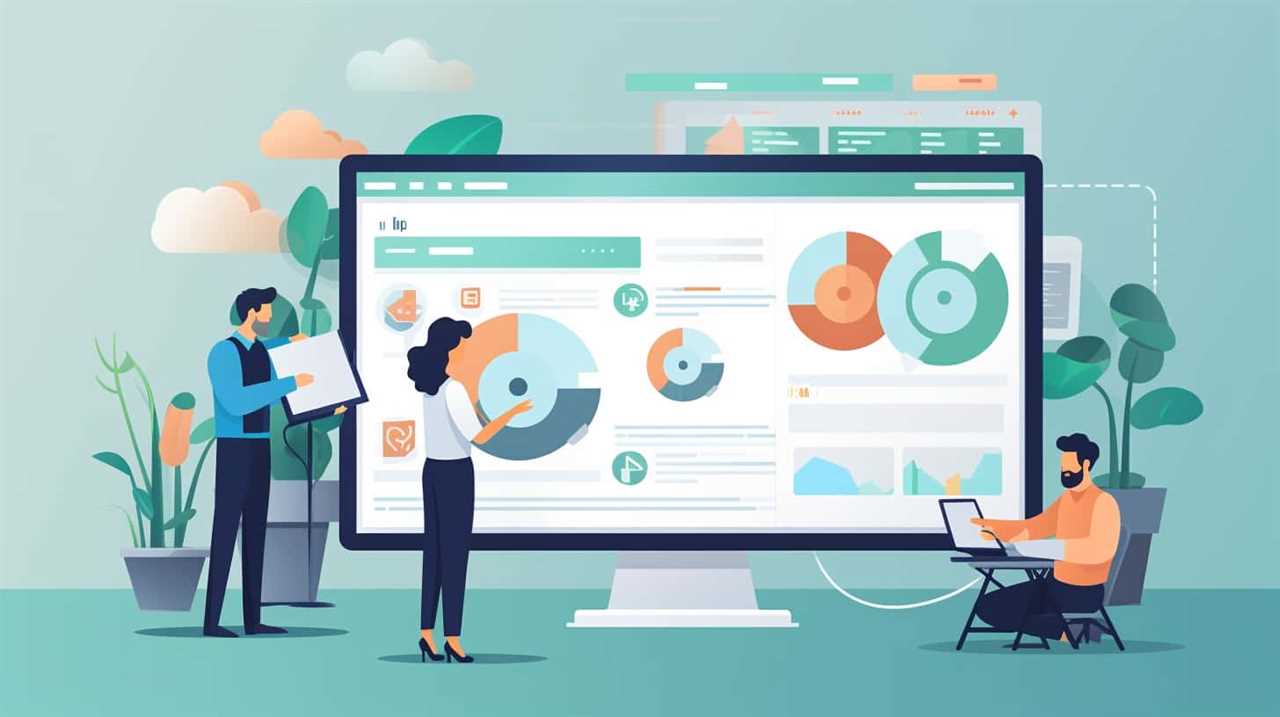Struggling to boost your website’s visibility? Look no further! We’ve crafted 8 SEO tactics for you that will significantly improve your website’s presence like never before.
By targeting relevant keywords, optimizing on-page elements, and improving loading speed, your website will stand out from the competition.
Create high-quality content, build strong backlinks, and utilize social media for promotion.
Don’t forget to optimize for mobile devices and regularly monitor performance.

Get ready to master the art of SEO and watch your website soar!
Key Takeaways
- Conduct thorough keyword research to target relevant keywords and increase organic traffic and search ranking.
- Optimize meta tags, page titles, headers, and URLs with targeted keywords to improve chances of appearing in relevant search results.
- Implement strategies to reduce website loading time, such as website caching, image optimization, compression techniques, and the use of a Content Delivery Network (CDN).
- Focus on delivering valuable content tailored to the target audience’s needs and expectations, using visuals, interactive elements, and compelling storytelling for engagement.
Target Relevant Keywords
One of the most important steps in improving our website’s visibility is to target relevant keywords. By doing so, we can increase organic traffic and boost our search ranking.
When selecting keywords, it’s crucial to focus on terms that our target audience is actively searching for. Conducting thorough keyword research allows us to identify these high-value terms and integrate them strategically into our website’s content. This helps search engines understand the relevance of our website to user queries and improves our chances of appearing in relevant search results.
Additionally, optimizing our meta tags, page titles, headers, and URLs with targeted keywords can further enhance our website’s visibility.

Optimize On-Page Elements
When it comes to optimizing on-page elements, two key factors to consider are the importance of the title tag and the optimization of the meta description.
The title tag plays a crucial role in telling search engines what your page is about, so it’s important to include relevant keywords and make it compelling.
Similarly, the meta description provides a brief summary of your page and can greatly impact click-through rates, so be sure to optimize it with relevant keywords and enticing language.
Title Tag Importance
In our article, we emphasize the importance of optimizing on-page elements, starting with the title tag.

Title tag optimization is a crucial aspect of SEO as it plays a significant role in improving the visibility and ranking of your website.
When it comes to title tag best practices, there are a few key things to consider.
Firstly, make sure your title tag accurately reflects the content of the page and includes relevant keywords.
Secondly, keep the title tag concise, usually around 50-60 characters, to ensure it’s fully displayed in search engine results.

Lastly, avoid using duplicate title tags across multiple pages to prevent confusion and dilution of search engine rankings.
Meta Description Optimization
Let’s continue our discussion on optimizing on-page elements by diving into the importance of meta description optimization.
Meta descriptions play a crucial role in attracting users to click on your website in search engine results. An effective meta description can significantly improve your website’s visibility and click-through rates.
To optimize your meta descriptions, follow these best practices.

First, keep them concise, around 150-160 characters, to ensure they’re fully displayed in search results.
Second, include relevant keywords that accurately reflect the content of the page. This not only helps search engines understand your content but also entices users to click.
Lastly, make your meta descriptions compelling and unique to differentiate your website from competitors.
Improve Website Loading Speed
Our aim is to significantly reduce website loading time by implementing effective strategies. Improving website loading speed is crucial for user experience and search engine optimization. Here are three key strategies to achieve faster loading times:

- Website Caching: Implementing a caching mechanism allows the website to store certain elements in the user’s browser, reducing the need to fetch them from the server on subsequent visits. This significantly improves loading speed.
- Image Optimization: Images often contribute to slower loading times. Optimize images by reducing their file size without compromising quality. Use compression techniques, such as resizing, cropping, and using the appropriate image format.
- Content Delivery Network (CDN): A CDN distributes website content across multiple servers worldwide, reducing the distance between the server and the user. This results in faster loading times by delivering content from the nearest server location.
Create High-Quality and Engaging Content
To create high-quality and engaging content, we should focus on delivering valuable information and captivating experiences to our audience.
A strong content strategy is essential in optimizing user experience and driving organic traffic to our website.
By understanding our target audience’s needs and interests, we can tailor our content to meet their expectations and provide them with valuable insights.
It’s important to conduct thorough research and stay updated with industry trends to ensure our content remains relevant and informative.

Additionally, we should aim to create engaging experiences through the use of visuals, interactive elements, and compelling storytelling.
Build High-Quality Backlinks
Building high-quality backlinks is crucial for improving your website’s visibility and SEO rankings. Backlinks are links from other websites that point to your site, and they serve as a vote of confidence for search engines.
Here are some effective strategies to build high-quality backlinks:
- Guest blogging: Contribute valuable content to authoritative websites in your industry and include a link back to your site.
- Broken link building: Find broken links on relevant websites and offer to replace them with your own content.
- Influencer outreach: Connect with influencers in your niche and ask them to share your content, which can lead to valuable backlinks.
Anchor text is also important when building backlinks. It’s the clickable text that contains a hyperlink, and it helps search engines understand the context of the linked page. Be strategic with your anchor text, using relevant keywords that accurately describe the linked page’s content.

Utilize Social Media for Promotion
When it comes to promoting our website, utilizing social media is crucial.
By engaging with our target audience on platforms like Facebook, Twitter, and Instagram, we can expand our online reach and increase brand awareness.
Social media allows us to share valuable content, interact with our followers, and drive traffic to our website, ultimately boosting our visibility and improving our SEO rankings.
Engage Target Audience
Engaging our target audience through the utilization of social media is crucial for promoting our website and boosting its visibility. Social media platforms provide an excellent opportunity to connect with our audience on a more personal level and increase user engagement.

Here are three key strategies to effectively engage our target audience using social media:
- Create compelling content: Develop informative and engaging posts that resonate with our audience. Use relevant keywords and hashtags to increase visibility and attract our target audience.
- Utilize interactive features: Encourage audience participation by using polls, quizzes, and contests. This not only increases engagement but also helps gather valuable insights about our audience.
- Respond and engage: Actively respond to comments, messages, and mentions. Engage in conversations, answer questions, and show appreciation for our audience’s support. This fosters a sense of community and builds trust.
Expand Online Reach
To further extend our online reach and promote our website, we can leverage the power of social media platforms. Social media has become a vital tool for businesses to expand their customer base and enhance online visibility.
By utilizing platforms such as Facebook, Twitter, Instagram, and LinkedIn, we can connect with a larger audience and increase brand awareness. It’s important to have a strategic approach to social media marketing, focusing on creating engaging and shareable content that resonates with our target audience.
Regularly posting updates, sharing relevant articles, and interacting with followers can help build a strong online presence and drive traffic to our website. Additionally, incorporating social media sharing buttons on our website can encourage visitors to share our content, further expanding our online reach.

Increase Brand Awareness
To enhance our brand awareness, we can effectively utilize social media for promotion by engaging with our audience and sharing compelling content. Social media platforms provide an excellent opportunity to connect with our target audience and increase our online visibility.
Here are three key strategies to enhance brand recognition:
- Consistent Posting: Regularly share relevant and engaging content to keep our brand at the forefront of our followers’ minds.
- Engage with Followers: Respond to comments, answer questions, and actively engage with our audience to foster a sense of community and build trust.
- Utilize Influencers: Collaborate with influencers relevant to our industry or niche to expand our reach and tap into their followers’ networks.
Optimize for Mobile Devices
We prioritize optimizing our website for mobile devices to enhance user experience and improve search engine rankings.
In today’s digital age, more and more people are accessing the internet through their smartphones and tablets. Therefore, having a mobile-friendly design is crucial for the success of our website.

A mobile-friendly design ensures that our site is easily accessible and readable on smaller screens, allowing users to navigate and interact with our content effortlessly.
Additionally, implementing responsive web design allows our website to adapt and adjust to different screen sizes and resolutions, providing a seamless and consistent user experience across all devices.
Regularly Monitor and Analyze Performance
Regularly, we monitor and analyze the performance of our website to ensure its visibility and improve our SEO efforts. This allows us to stay on top of any issues that may arise and make necessary adjustments to maintain a strong online presence.
To effectively monitor our website’s performance, we focus on three key areas:

- Monitoring trends: We closely track the latest industry trends and stay updated on changes in search engine algorithms. This helps us identify new opportunities and adapt our SEO strategies accordingly.
- Competitor analysis: We regularly analyze our competitors’ websites to understand their SEO tactics and identify areas where we can improve. By staying informed about our competitors, we can adjust our strategies and stay ahead in the search rankings.
- Performance metrics: We use various tools to measure our website’s performance, including metrics such as traffic, bounce rate, and conversion rate. This data allows us to identify areas for improvement and make data-driven decisions to optimize our website.
Frequently Asked Questions
How Do I Choose the Most Effective Keywords for My Website?
When choosing the most effective keywords for our website, we start with thorough keyword research. This helps us identify relevant and high-ranking keywords that we can then optimize throughout our content for maximum visibility.
What Are Some Techniques to Improve the Loading Speed of My Website?
Improving website loading speed is crucial for website optimization. Techniques include optimizing code, compressing images, and using caching. These methods reduce page load time, improving user experience and SEO rankings.
How Can I Create Engaging Content That Will Keep Visitors on My Website?
We’ve found that creating engaging content is key to keeping visitors on our website. By using storytelling techniques, visual elements, and interactive features, we’ve been able to captivate our audience and increase their time spent on our site.
What Are Some Strategies to Build High-Quality Backlinks for My Website?
To build high-quality backlinks for our website, we can utilize guest blogging and collaborate with influencers. These strategies help us increase our online presence and improve our website’s search engine optimization.

How Can I Effectively Utilize Social Media Platforms to Promote My Website?
We can effectively utilize social media platforms to promote our website by implementing various social media marketing techniques. This includes maximizing website promotion through social media by creating engaging content, utilizing hashtags, and leveraging influencer partnerships.
Conclusion
By implementing these eight SEO tips, you can significantly improve your website’s visibility and presence.
Targeting relevant keywords, optimizing on-page elements, and creating high-quality content are just a few strategies that can propel your website to new heights.
Don’t forget to build high-quality backlinks, utilize social media, optimize for mobile devices, and regularly monitor your performance.

With these techniques, you’ll be on the path to success and watch your website’s presence soar.









